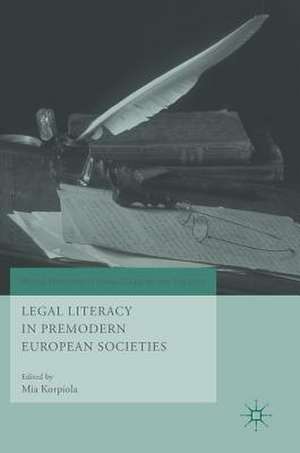Legal Literacy in Premodern European Societies: World Histories of Crime, Culture and Violence
Editat de Mia Korpiolaen Limba Engleză Hardback – 20 oct 2018
This book analyses the legal literacy, knowledge and skills of people in premodern and modernizing Europe. It examines how laymen belonging both to the common people and the elite acquired legal knowledge and skills, how they used these in advocacy and legal writing and how legal literacy became an avenue for social mobility. Taking a comparative approach, contributors consider the historical contexts of England, Finland, France, Germany, Italy and Sweden.
This book is divided into two main parts. The first part discusses various groups of legal literates (scriveners, court of appeal judges and advocates) and their different paths to legal literacy from the Middle Ages to the nineteenth century. The second part analyses the rise of the ownership and production of legal literature – especially legal books meant for laymen – as means for acquiring a degree of legal literacy from the eighteenth to the early twentieth century.
| Toate formatele și edițiile | Preț | Express |
|---|---|---|
| Paperback (1) | 723.69 lei 6-8 săpt. | |
| Springer International Publishing – 12 ian 2019 | 723.69 lei 6-8 săpt. | |
| Hardback (1) | 728.91 lei 6-8 săpt. | |
| Springer International Publishing – 20 oct 2018 | 728.91 lei 6-8 săpt. |
Din seria World Histories of Crime, Culture and Violence
- 9%
 Preț: 815.58 lei
Preț: 815.58 lei - 20%
 Preț: 754.14 lei
Preț: 754.14 lei -
 Preț: 260.81 lei
Preț: 260.81 lei -
 Preț: 383.12 lei
Preț: 383.12 lei - 15%
 Preț: 699.12 lei
Preț: 699.12 lei - 15%
 Preț: 700.29 lei
Preț: 700.29 lei -
 Preț: 449.90 lei
Preț: 449.90 lei - 8%
 Preț: 590.56 lei
Preț: 590.56 lei - 15%
 Preț: 695.85 lei
Preț: 695.85 lei - 15%
 Preț: 586.23 lei
Preț: 586.23 lei - 15%
 Preț: 583.13 lei
Preț: 583.13 lei - 15%
 Preț: 589.84 lei
Preț: 589.84 lei - 18%
 Preț: 730.47 lei
Preț: 730.47 lei - 18%
 Preț: 725.26 lei
Preț: 725.26 lei - 18%
 Preț: 890.06 lei
Preț: 890.06 lei -
 Preț: 318.29 lei
Preț: 318.29 lei
Preț: 728.91 lei
Preț vechi: 888.91 lei
-18% Nou
Puncte Express: 1093
Preț estimativ în valută:
139.49€ • 144.81$ • 116.31£
139.49€ • 144.81$ • 116.31£
Carte tipărită la comandă
Livrare economică 22 martie-05 aprilie
Preluare comenzi: 021 569.72.76
Specificații
ISBN-13: 9783319968629
ISBN-10: 3319968629
Pagini: 276
Ilustrații: X, 264 p. 1 illus.
Dimensiuni: 148 x 210 mm
Greutate: 0.48 kg
Ediția:1st ed. 2019
Editura: Springer International Publishing
Colecția Palgrave Macmillan
Seria World Histories of Crime, Culture and Violence
Locul publicării:Cham, Switzerland
ISBN-10: 3319968629
Pagini: 276
Ilustrații: X, 264 p. 1 illus.
Dimensiuni: 148 x 210 mm
Greutate: 0.48 kg
Ediția:1st ed. 2019
Editura: Springer International Publishing
Colecția Palgrave Macmillan
Seria World Histories of Crime, Culture and Violence
Locul publicării:Cham, Switzerland
Cuprins
Introduction; Mia Korpiola.- Part One: Legal Literates and Their Paths to Legal Literacy.- Legal Education in Late Medieval England: How did Provincial Scriveners Learn their Law?; Kitrina Bevan.- The Imperial Chamber Court as an Educational and Training Institution; Anette Baumann.- Legal Learning of Various Kinds: Swedish Court of Appeal Judges in the Seventeenth Century; Marianne Vasara-Aaltonen.- The Agency and Practical Learning of a Lay Advocate in Seventeenth-Century Helsinki: The Case of Gabriel Abrahamsson; Petteri Impola.- Ideal Types and Odd Men Out: Legal Literacy and Social Mobility in Nineteenth-Century Finland; Anna Kuismin.- Part Two: (Popular) Legal Literature as a Means to Legal Literacy.- Legal Literates in Eighteenth-Century Swedish Towns: Evidence of Book Ownership in Estate Inventories (Helsinki, Oulu, Porvoo and Kokkola); Mia Korpiola.- Popular Legal Manuals as Sources and Mechanisms of Acquiring Legal Literacy; AnnamariaMonti.- Acquiring Legal Literacy by Reading: Popular Legal Literature in Nineteenth Century France; Laetitia Guerlain and Nader Hakim.- Index.
Notă biografică
Mia Korpiola is Professor of Legal History at the University of Turku, Finland. She has (co-)edited several books, including Regional Variations in Matrimonial Law and Custom in Europe, 1150-1600 (2011), The Svea Court of Appeal in the Early Modern Period (2014) and Planning for Death: Wills and Death-Related Property Arrangements in Europe, 1200-1600 (2018).
Textul de pe ultima copertă
This book analyses the legal literacy, knowledge and skills of people in premodern and modernizing Europe. It examines how laymen belonging both to the common people and the elite acquired legal knowledge and skills, how they used these in advocacy and legal writing and how legal literacy became an avenue for social mobility. Taking a comparative approach, contributors consider the historical contexts of England, Finland, France, Germany, Italy and Sweden.
This book is divided into two main parts. The first part discusses various groups of legal literates (scriveners, court of appeal judges and advocates) and their different paths to legal literacy from the Middle Ages to the nineteenth century. The second part analyses the rise of the ownership and production of legal literature – especially legal books meant for laymen – as means for acquiring a degree of legal literacy from the eighteenth to the early twentieth century.
Caracteristici
Analyses the whole spectrum of legal literacy across Europe from Medieval times to the nineteenth century Use sources rarely used in legal history research, such as autobiographical texts, newspapers, and estate inventories Takes an interdisciplinary and comparative approach to the subject
